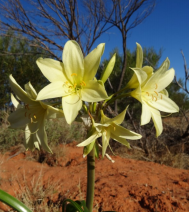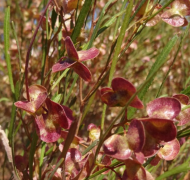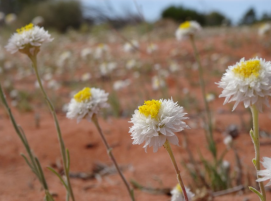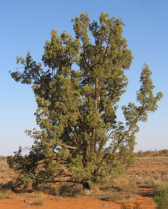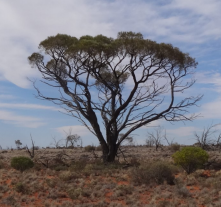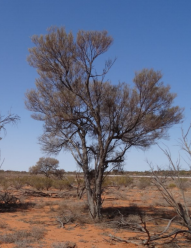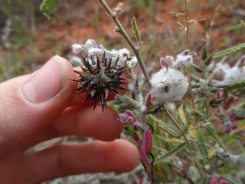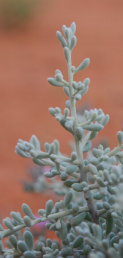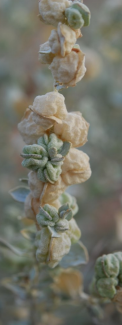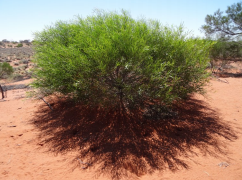Common Plants of the Roxby Downs Region
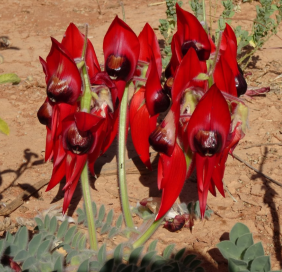
Sturt's Deset Pea (Swainsona Formosa)
The Floral emblem of South Australia
ID: Unmistakable when in flower. Flowers usually red with black centre (“boss”), but the colours of the petals and boss can vary from red to pink and white.
Where to see: After rain; town verges and Borefield Rd.
Sturt's Desert Pea's are protected in South Australia. Look but don’t touch! Please leave them for others to appreciate.
Andamooka Lily (Crinum Flaccidum)
ID: Up to 50cm tall, with distinctively pretty pale-yellow flowers. Very smelly, also known as the Stink Lily.
Where to see: After rain in summer and autumn in creek lines and flood plains in Andamooka.
Hopbush (dodonaea viscosa ssp. Angustissima)
ID: Large shrub, similar at first glance to Sandhill Wattle, but has far “waxier” leaves. Seed capsules can be vividly coloured, with four “wings” to help with winddispersal.
Where to see: Common on sand dunes.
Poached Egg Daisy (Polycalymma Stuartii)
ID: Small herbs, 10-50cm tall, with long, thin stems and gorgeous "poached egg" flowers.
Where to see: After rain on sand dunes
Cypress Pine (Callitris Glaucophylla)
ID: Up to 18m tall, the only pine tree in the area. Young trees are symmetrical and coneshaped, becoming less symmetrical with age.
Where to see: Olympic Way - between Roxby Downs and Olympic Dam. Pines in the area have been aged to 250 years old.
Western Myall (Acacia Papyrocarpa)
ID: Tree up to 7m tall, often with neat, round and shady canopies.
Where to see: Flat ground, often near bluebushes. Corner of Olympic Way and Borefield Rd, Stuart Highway between Pimba and Coober Pedy.
Mulga (Acacia Aneura)
ID: Up to 10m tall, with needle-like leaves. Flowers are spike shaped and bright yellow.
Where to see: Dune edges, Arid Recovery.
Elaborate processing allowed Indigenous Australians to use this plant to create pastes and “bush lollies”.
Cannonball (Dissocarpus Paradoxus)
ID: Small herb, less than 50cm. Flowers and “fruit” are woolly and spherical, with many spines. Wool falls off when fruits are on the floor.
Where to see: Flat swales, mulga patches. Easy to find if barefoot! (Another reason to always wear closed-in shoes in the bush)
Pearl Bluebush (Maireana Astrotricha)
ID: Blueish-grey shrub. Leaves shorter than 1cm, oval-shaped and succulent.
Where to see: Flat, hard soils (“swales”) between sand dunes.
Lives up to 300 years. Leaves are high in protein and salt and can be overgrazed by rabbits and livestock.
Bladder Saltbush (Atriplex Vesicaria)
ID: Low shrub, 40-80cm high. Leaves flat and roughly triangular, becoming fleshy after rain. Flowers “bladdery”.
Where to see: Flat, hard soils (“swales”) between sand dunes. Salt lake edges.
Leaves edible (tastes salty!)
Sandhill Wattle (Acacia Ligulata)
ID: Large shrub, normally 1-2m tall. Circular, bright yellow flowers. Creates long seed pods, which are often visible on plant long after the seeds have popped out.
Where to see: Common on sand dunes.
Common Plants - printable brochure

